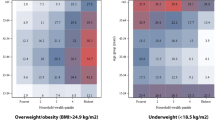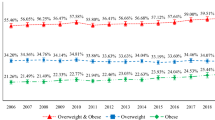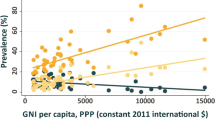Abstract
Objective:
To estimate variation between small areas in adult body mass index (BMI), and assess the importance of area level socioeconomic disadvantage in predicting BMI.
Methods:
We identified all census collector districts (CCDs) in the 20 innermost Local Government Areas in metropolitan Melbourne, Australia, and ranked them by the percentage of low income households (<$400/week). In all, 50 CCDs were randomly selected from the least, middle and most disadvantaged septiles of the ranked list and 4913 residents (61.4% participation rate) completed one of two surveys. Multilevel linear regression was used to estimate area level variance in BMI and the importance of area level socioeconomic disadvantage in predicting BMI.
Results:
There were significant variations in BMI between CCDs for women, even after adjustment for individual and area SES (P=0.012); significant area variation was not found for men. Living in the most versus least disadvantaged areas was associated with an average difference in BMI of 1.08 kg/m2 (95% CI: 0.48–1.68 kg/m2) for women, and of 0.93 kg/m2 (95% CI: 0.32–1.55 kg/m2) for men. Living in the mid versus least disadvantaged areas were associated with an average difference in BMI of 0.67 kg/m2 (95% CI: 0.09–1.26 kg/m2) for women, and 0.43 kg/m2 for men (95% CI: −0.16–1.01).
Conclusion:
These findings suggest that area disadvantage is an important predictor of adult BMI, and support the need to focus on improving local environments to reduce socioeconomic inequalities in overweight and obesity.
This is a preview of subscription content, access via your institution
Access options
Subscribe to this journal
Receive 12 print issues and online access
$259.00 per year
only $21.58 per issue
Buy this article
- Purchase on Springer Link
- Instant access to full article PDF
Prices may be subject to local taxes which are calculated during checkout
Similar content being viewed by others
References
Olshansky SJ, Passaro D, Hershow R, Layden J, Carnes BA, Brody J et al. A potential decline in life expectancy in the United States in the 21st century. N Engl J Med 2005; 352: 1138–1145.
World Health Organization. Obesity: preventing and managing the global epidemic. Report of a WHO consultation. Technical Report Series 894. WHO: Geneva, 2000.
Australian Institute of Health and Welfare. A growing problem: trends and patterns in overweight and obesity among adults in Australia, 1980–2001. AIHW: Canberra, 2003.
Flegal KM, Carroll MD, Ogden CL, Johnson CL . Prevalence and trends in obesity among US adults, 1999-2000. JAMA 2002; 288: 1723–1727.
Ball K, Crawford D . Socioeconomic status and weight change in adults: a systematic review. Soc Sci Med 2005; 60: 1987–2010.
Zhang Q, Wang Y . Socioeconomic inequality of obesity in the United States: do gender, age, and ethnicity matter? Soc Sci Med 2004; 58: 1171–1180.
Reijneveld SA . The impact of individual and area characteristics on urban socioeconomic differences in health and smoking. Int J Epidemiol 1998; 27: 33–40.
Sundquist J, Johansson S . The influence of socioeconomic status, ethnicity and lifestyle on body mass index in a longitudinal study. Int J Epidemiol 1998; 27: 57–63.
Giles-Corti B, Macintyre S, Clarkson JP, Pikora T, Donovan RJ . Environmental and lifestyle factors associated with overweight and obesity in Perth, Australia. Am J Health Prom 2003; 18: 93–102.
Diez-Roux AV . Investigating neighborhood and area effects on health. Am J Public Health 2001; 91: 1783–1789.
Swinburn B, Egger G, Razza F . Dissecting obesogenic environments: the development and application of a framework for identifying and prioritising environmental interventions for obesity. Prev Med 1999; 29: 563–570.
Peters JC . Combating obesity: challenges and choices. Obes Res 2003; 11 (Suppl.): S7–S11.
Hill J, Peters J . Environmental contributions to the obesity epidemic. Science 1998; 280: 1371–1374.
Robert SA, Reither EN . A multilevel analysis of race, community disadvantage and body mass index among adults in the US. Soc Sci Med 2004; 59: 2421–2434.
Ellaway A, Anderson A, Macintyre S . Does area of residence affect body size and shape? Int J Obes Relat Metab Disord 1997; 21: 304–308.
Davey Smith G, Hart C, Watt G, Hole D, Hawthorne V . Individual social class, area-based deprivation, cardiovascular disease risk factors, and mortality: the Renfrew and Paisley study. J Epidemiol Community Health 1998; 52: 399–405.
Sundquist J, Malmstrom M, Johansson SE . Cardiovascular risk factors and the neighbourhood environment: a multilevel analysis. Int J Epidemiol 1999; 28: 841–845.
Chaix B, Chauvin P . Tobacco and alcohol consumption, sedentary lifestyle and overweightness in France: a multilevel analysis of individual and area-level determinants. Eur J Epidemiol 2003; 18: 531–538.
Diez-Roux AV, Link BG, Northridge ME . A multilevel analysis of income inequality and cardiovascular disease risk factors. Soc Sci Med 2000; 50: 673–687.
Australian Bureau of Statistics. 2001 Census of Population and Housing: How Australia Takes a Census: Australian Bureau of Statistics 2000, Report No.: 2903.0.
Dillman DA . Mail and Internet Surveys: The Tailored Design Method Second Edition: John Wiley & Sons Inc, 2000.
Turrell G, Hewitt B, Patterson C, Oldenburg B . Measuring socioeconomic position in dietary research: is choice of socioeconomic indicator important? Public Health Nutr 2003; 6: 191–200.
Australian Bureau of Statistics. Australian standard classification of occupations: dictionary (Second edition). Catalogue No. 1220.0; 1997.
Rasbash J, Browne W, Goldstein H, Yang M, Plewis I, Healy M et al. A User's Guide to MLwiN, Version 2.1. Institute of Education, University of London: London, 2000.
Goldstein H . Multilevel Statistical Models. Arnold: London, 2003.
Rose G . Sick individuals and sick populations. Int J Epidemiol 1985; 14: 32–38.
Lopez R . Urban sprawl and risk for being overweight or obese. Am J Public Health 2004; 94: 1574–1579, 2004 Sep.
Ewing R, Schmid T, Killingsworth R, Zlot A, Raudenbush S . Relationship between urban sprawl and physical activity, obesity, and morbidity. Am J Health Prom 2003; 18: 47–57.
Frank LD, Andresen MA, Schmid TL . Obesity relationships with community design, physical activity, and time spent in cars. Am J Prev Med 2004; 27: 87–96.
Frank LD, Pivo G . Impacts of mixed use and density on utilization of three modes of travel: single-occupant vehicle, transit, and walking. Transportation Res Rec 1994; 1466: 44–52.
Reidpath DD, Burns C, Garrard J, Mahoney M, Townsend M . An ecological study of the relationship between social and environmental determinants of obesity. Health Place 2002; 8: 141–145.
Block JP, Scribner RA, DeSalvo KB . Fast food, race/ethnicity, and income: a geographic analysis. Am J Prev Med 2004; 27: 211–217.
Diez Roux AV . Estimating neighbourhood health effects: the challenges of causal inference in a complex world. Soc Sci Med 2004; 58: 1953–1960.
Turrell G, Patterson C, Oldenburg B, Gould T . The socioeconomic patterning of survey participation and non-response error in a multilevel study of food purchasing behaviours: area and individual-level characteristics. Public Health Nutr 2003; 6: 181–189.
Niedhammer I, Bugel I, Bonenfant S, Goldberg M, Leclerc A . Validity of self-reported weight and height in the French GAZEL cohort. Int J Obes 2000; 24: 1111–1118.
Boyle MH, Wilms JD . Place effects for areas defined by administrative boundaries. Am J Epidemiol 1999; 149: 577–585.
Curtis S, Jones I . Is there a place for geography in the analysis of health inequality? Soc Health Illness 1998; 20: 645–672.
Diez-Roux AV, Nieto FJ, Caulfield L, Tyroler HA, Watson RL, Szklo M . Neighbourhood differences in diet: the Atherosclerosis Risk in Communities (ARIC) Study. J Epidemiol Community Health 1999; 53: 55–63.
Acknowledgements
The project was funded by the Victorian Health Promotion Foundation. The second author is supported by a Victorian Health Promotion Foundation (VicHealth) Senior Research Fellowship. The fourth and fifth authors are supported by National Health and Medical Research Council/National Heart Foundation Career Development Awards.
We are grateful to all staff that contributed to the project, and are particularly grateful to Ms Emma Rawlings for her work on the survey administration, data collection and cleaning.
Author information
Authors and Affiliations
Corresponding author
Additional information
Ethics approval
The project was approved by the La Trobe University Human Ethics Committee.
Rights and permissions
About this article
Cite this article
King, T., Kavanagh, A., Jolley, D. et al. Weight and place: a multilevel cross-sectional survey of area-level social disadvantage and overweight/obesity in Australia. Int J Obes 30, 281–287 (2006). https://doi.org/10.1038/sj.ijo.0803176
Received:
Accepted:
Published:
Issue Date:
DOI: https://doi.org/10.1038/sj.ijo.0803176
Keywords
This article is cited by
-
Household income, active travel, and their interacting impact on body mass index in a sample of urban Canadians: a Bayesian spatial analysis
International Journal of Health Geographics (2019)
-
Are dietary inequalities among Australian adults changing? a nationally representative analysis of dietary change according to socioeconomic position between 1995 and 2011–13
International Journal of Behavioral Nutrition and Physical Activity (2018)
-
A qualitative study of the infant feeding beliefs and behaviours of mothers with low educational attainment
BMC Pediatrics (2016)
-
Does the presence and mix of destinations influence walking and physical activity?
International Journal of Behavioral Nutrition and Physical Activity (2015)
-
Do sedentary behaviors mediate associations between socio-demographic characteristics and BMI in women living in socio-economically disadvantaged neighborhoods?
International Journal of Behavioral Nutrition and Physical Activity (2015)



